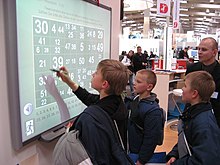This article includes a list of general references, but it lacks sufficient corresponding inline citations. (January 2014) |


An interactive whiteboard (IWB), also known as interactive board, interactive display, interactive digital board or smart board, is a large interactive display board in the form factor of a whiteboard. It can either be a standalone touchscreen computer used independently to perform tasks and operations, or a connectable apparatus used as a touchpad to control computers from a projector. They are touch screen enabled small computers.They are used in a variety of settings, including classrooms at all levels of education, in corporate board rooms and work groups, in training rooms for professional sports coaching, in broadcasting studios, and others.
The first interactive whiteboards were designed and manufactured for use in the office.[citation needed] They were developed by PARC around 1990.[citation needed] This board was used in small group meetings and round-tables.[citation needed]
The interactive whiteboard industry was expected to reach sales of US$1 billion worldwide by 2008; one of every seven classrooms in the world was expected to feature an interactive whiteboard by 2011 according to market research by Futuresource Consulting.[1] In 2004, 26% of British primary classrooms had interactive whiteboards.[2] The Becta Harnessing Technology Schools Survey 2007 indicated that 98% of secondary and 100% of primary schools had IWBs.[3] By 2008, the average numbers of interactive whiteboards rose in both primary schools (18 compared with just over six in 2005, and eight in the 2007 survey) and secondary schools (38, compared with 18 in 2005 and 22 in 2007).[4]
- ^ Davis, Michelle R. (12 September 2007). "Whiteboards Inc. - Education Week". Digital Directions – via Education Week.
- ^ Poulter, Tony. "Interactive Whiteboards: Research". Interactive Whiteboards. Archived from the original on 31 July 2012. Retrieved 31 July 2012.
- ^ Kitchen, Sarah; Finch, Steven; Sinclair, Rupert (July 2007), "3.1 ICT hardware" (PDF), Harnessing Technology schools survey 2007, British Educational Communication and Technology Agency, p. 35, archived from the original (PDF) on 13 October 2009
- ^ "Harnessing Technology schools survey 2008". Becta. 14 October 2008. Archived from the original on 15 December 2009. Retrieved 15 December 2009.